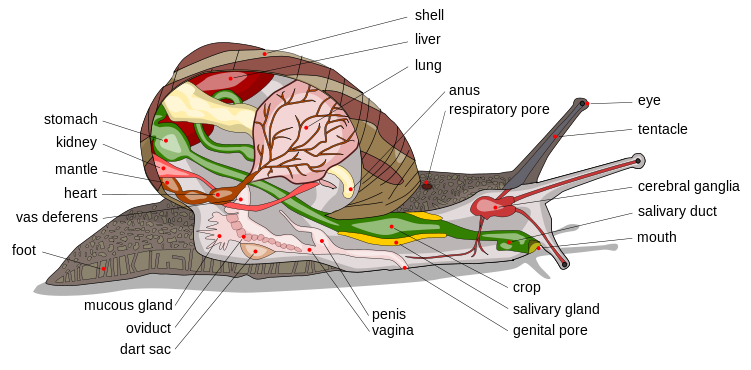
Reproduction
REPRODUCTIVE ANATOMY
The reproduction process of a typical Pulmonate, indicative of Millerelix lithica, can be a strange concept since they are hermaphroditic organisms possessing both male and female reproductive organs (Pratt 1981). Even among closely related snails, there are subtle differences in reproductive anatomy allowing classification distinctions to be made for various genera and species. There is a basic reproductive plan hermaphroditic land snails abide by. For starters, gametogenesis takes place in the ovitestis where both sperm and ova are formed, and both the male and female tracts remain combined temorarily as the hermaphroditic duct (Pratt 1981). Eventually male and female ducts differentiate, but both tracts remain closely associated with one another in the snail's body. To receive a more detailed description of Millerelix and closely related genera's reproductive anatomy, William Pratt's dissertation explains all of its intricacies.
Snails in the Family of Polygyridae don't possess "love darts" (Pilsbry 1940)
HOW THEY LIKE IT
Primetime for mating begins in early spring and lasts into the summer (Branson 1961). During this time of year, the conditions are right because the temperatures are rising and the moisture is high which suits the snails and soon to be offspring. The time and location of copulation also serves the purpose for minimizing water loss. In most cases, Polygyridae come out at night to mate, and they prefer the intimacy under cover provided by the forest (Branson 1961). Before the actual act, many snails in the order Stylommatophora have a variety of courtship rituals to get the adrenaline pumping. Some of these rituals have elaborate guidelines and can last hours (Tompa 1984). No information was directly found about the details of Millerelix lithica and its mating preferences.
THE MAIN EVENT
Although all components required to create new life exists in each snail, most practice cross fertilization. The process begins by both Polygyridae snails releasing seminal contents onto one another via the penis (Pratt 1981). The semen is then drawn back into the body by retraction of the penis (Pratt 1981). Once in the body, fertilization of the egg and sperm occurs leading formation of a zygote which will eventually develop into a new snail.
THE NEXT GENERATION
Generally speaking, Pulmonates deposit a multitude of eggs shortly after copulation. This description of oviposition, laying of eggs, is described by Baker (1939) of the species Polygyra albolabris which is closely related to the genus Millerelix. It is also stated that the eggs are left in moist locations under debris where they are left to develop (Baker 1939). Once the offspring hatch, they emerge as miniature representation of their parents. All terrestrial snails lack larval stages which is commonly seen in marine gastropods, and instead develops as juvenile forms. This type of development is known as a direct life cycle.
Check out our references for further reading on Millerelix lithica
home
|
classification |
controversy
| habitat
| adaptation
| nutrition
| reproduction
| references
|
contact
last updated November 29, 2012
